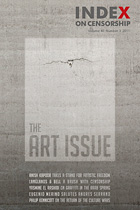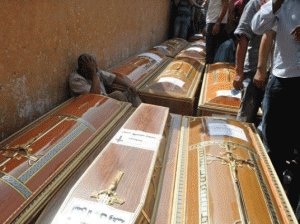On 9 October, 27 demonstrators protesting attacks against churches were murdered outside Egypt’s state TV building. Yasmine El-Rashidi asks why the media is silencing one side of the story
For anyone who witnessed the violence that unfolded on the evening of 9 October outside the state TV building in Egypt, there is no doubt that something had changed. What was intended to be a peaceful march by the Coptic communityturned into something of a massacre. We watched heavily armoured vehicles trample protesters; we witnessed military police beating young men; thugs wreaking havoc with bludgeons, knives, glass and swords. Molotov cocktails rained down on us, and by the evening’s end, the once pristine street was a site of devastation, blood and broken glass and even flesh on the ground, burned and overturned vehicles still in flames, and empty bullets cartridges lying around.
It was a sight some of us had seen before. At the height of the revolution in February, pro-Mubarak protesters and thugs were unleashed on Tahrir Square, doing much of the same. But that evening, something was different.
On that night, I watched Egyptians turn against each other in what became not a military massacre, as the media is reporting, but rather a sectarian battle. What started as a crackdown by the army as it tried to deter protesters away from the state TV and Radio building, turned into a very clear assault of Muslims against Copts. The Muslims came from various walks of life: there were military men, young, conscripts in the army, who were likely raised on the common belief that “Christians are going to hell”; there were thugs, roughed-up types from alleyways in neighbourhoods nearby who had likely watched state TV announcing that “armed Copts are killing our soldiers” and gone down to rescue them; and there were youth as young as 11 who had heard about the mayhem and came to join for the thrill. These young boys, feverish and their adrenaline high, threw rocks and glass and beat Christians up, as if in a game.This is particularly significant in a country where 60 percent of the population is under the age of 25, where opportunity is low and where frustration is high.
I watched as Muslims butchered Copts. I watched mobs chanting for an Islamic state, vowing to kill any Christian they could lay their hands on, assaulting Copts — men and women — as if they were cattle. “Coptic blood,” one young man boasted as he emerged from a crowd in whose midst two young, until then perhaps hopeful, Copts lay. They were a couple, newly engaged. And I watched the soft-faced Vivian Magdy hold the hand of Michael Mosad, her fiancé, gripping it, refusing to let go. “I won’t leave him,” she sobbed, as she sat beside his body in the morgue. He had been dragged beneath an army APC, his legs almost severed, his organs ruptured. As he lay on the sidewalk, gasping for breath, he was then brutally beaten; by a Muslim who screamed at a sobbing Vivian who was crying for help, calling her an infidel. They too were newly engaged — two months. Michael was twenty-three.
What I witnessed was the reality of a population that readily turned on its own; young boys, mobs, hooligans, the underclass, so willingly emerged from the alleyways and nearby side-streets to attack the Copts. Urged by State TV to go down and defend Egypt’s soldiers, “the protectors of the revolution”, hundreds vehemently did. The real tragedy is that: the readiness of a young underclass so willing to kill.
In the days since that bloody Sunday, as I have shared moments with families mourning their loved ones, observed the military grapple to contain a situation that escalated into something they clearly did not want it to become, and monitored the news unfold, my concern for a situation becomes even greater as I watch the media — in particular the international press — narrate a story that seems to have just one side. Although the military, as the de facto rulers of the country, are to blame for their slipping grip on the nation and their inability to provide citizens the very basics of an environment that is safe, the journalistic campaign for the SCAF to step down raises fundamental questions about the blurring line of journalists who covered the revolution, supported it, and have become more of advocates of it than critical witnesses. Surely I couldn’t have been the only English-speaking writer and journalist there who witnessed the other side of that story?

Yasmine El-Rashidi is a writer based in Cairo. Her article entitled “Art or Vandalism?” appears in the new edition of Index on Censorship. Click on The Art Issue for subscription options and more.





